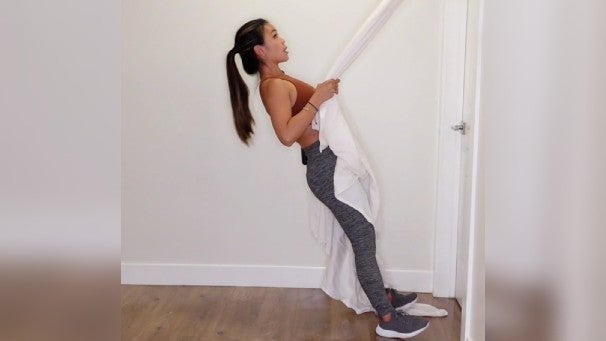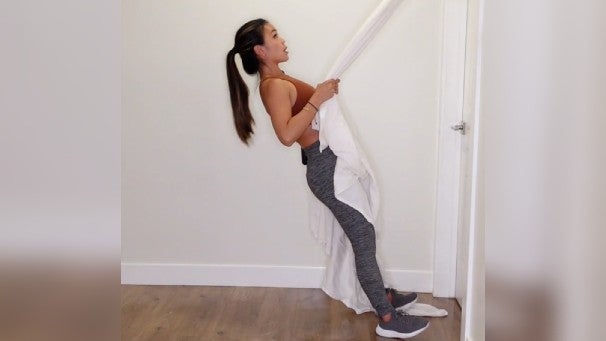
6 Ways to Do Inverted Rows at Home

Get full access to Outside Learn, our online education hub featuring in-depth fitness and nutrition courses and more than 2,000 instructional videos when you
sign up for Outside+.
If you’re working out from home, the back muscles are probably some of the hardest to hit using traditional movements you’d do in the gym. Thankfully, with a bit of creativity, you can make inverted rows work.
The inverted row is a pulling exercise that uses your own body weight as resistance. It works primarily your back muscles as well as your biceps. Here are six different ways you can do them from home!
Sohee Lee is one of your Oxygen Challenge 8 Coaches. Find out all you need to know about OC8 here!
1. Lebert Equalizer Row
If you have a set of Lebert Equalizers or something similar, doing inverted rows with these is super seamless. For this, you want the equalizers sitting parallel to each other about 18 inches apart. Lie down in between them with your arms on the handles, then do a glute bridge with the legs bent and hold the top of that position with your hips. This is your starting point! From here, think of keeping your chest up as your drive your elbows down into the ground. Come up as high as you can go (your chest should be at least level with the equalizers) before lowering back down under control. Perform as many full-range repetitions as you can.
To increase the difficulty of the movement, you can elevate the feet on a chair or something 12-24” tall.
2. Chairs + Dowel Row
This setup can work incredibly well, but only if you have the right type of chairs and a very sturdy dowel that will definitely, definitely support your body weight (see 1:40 in the above Instagram video). If you happen to have chairs with straight tops (not curved) and a dowel or a strong metal rode. Once again, for safety purposes, you must be certain the dowel will not snap on you!
Position the chairs and the dowel such that the dowel the backs of the chairs are facing each other and the dowel is lying horizontally across the chairs. Get down between the chairs similarly to how you would set up with the equalizers, except this time, you’re using a pronated (overhand) rather than neutral grip. Again, starting at the top of a glute bridge position, row your body upwards as high as you can go (or until your chest touches the rod), then lower under control.
3. Table Inverted Row
If you have a heavy, strong table that you can slide your body under, this can make for a surprisingly smooth setup (see 3:28 in the above Instagram video). However, I must insist that you take the first time that you ensure your table can support your body weight and will not break or flip over on top of you.
If your table looks anything like mine, you should be able to grip the edge of the table with no issues. If you’re unsure, don’t risk it.
4. Suspension Trainer Row
If you have suspension straps, they might come with a door stopper that is designed such that you can perform exercises with the strap anchored by a shut door (see 4:47 in the above Instagram video). The straps should be anchored in such a way that when you pull on them, the door will not swing open.
You can keep the legs straight as you do these, or you can alternatively perform these with bent legs. Remember that the more parallel to the ground your body is, the more difficult the exercise, so be sure to angle your body according to your own strength level.
5. Bed Sheet Inverted Row
Take a bedsheet and tie a knot in one corner. Toss the knot over the top of a door, then shut the door. The knot should be on the opposite side of the direction in which the door moves to shut (see 6:49 in the above Instagram video).
Grab the bedsheet in either hand, then carefully lower the body back until the arms are extended. Your feet should be pressed up against or close to the door.
Keeping the body in a straight line and with the glutes squeezed, drive the elbows into the ground to pull your body up. Once the arms are fully flexed, carefully reverse the motion and lower yourself back down until the arms are fully extended again.
6. Partner Inverted Row
For this one, you’ll need a strong partner who can support your body weight. Clasp your hands around their upper arms, then get into the top of the glute bridge position underneath them (see 8:09 in the above Instagram video). Row your body up towards them while they hold a bent over hinge position throughout the duration of your entire set.
So there you have it — six non-traditional ways to do rows from home. As you can see, there are ways to work the back muscles, even if you don’t have a squat rack, a pull-up bar, or standard weights like barbells and dumbbells.
Don’t be afraid to experiment around with these methods, and remember to stay safe at all times!
Published at Thu, 21 Apr 2022 14:44:05 -0700






